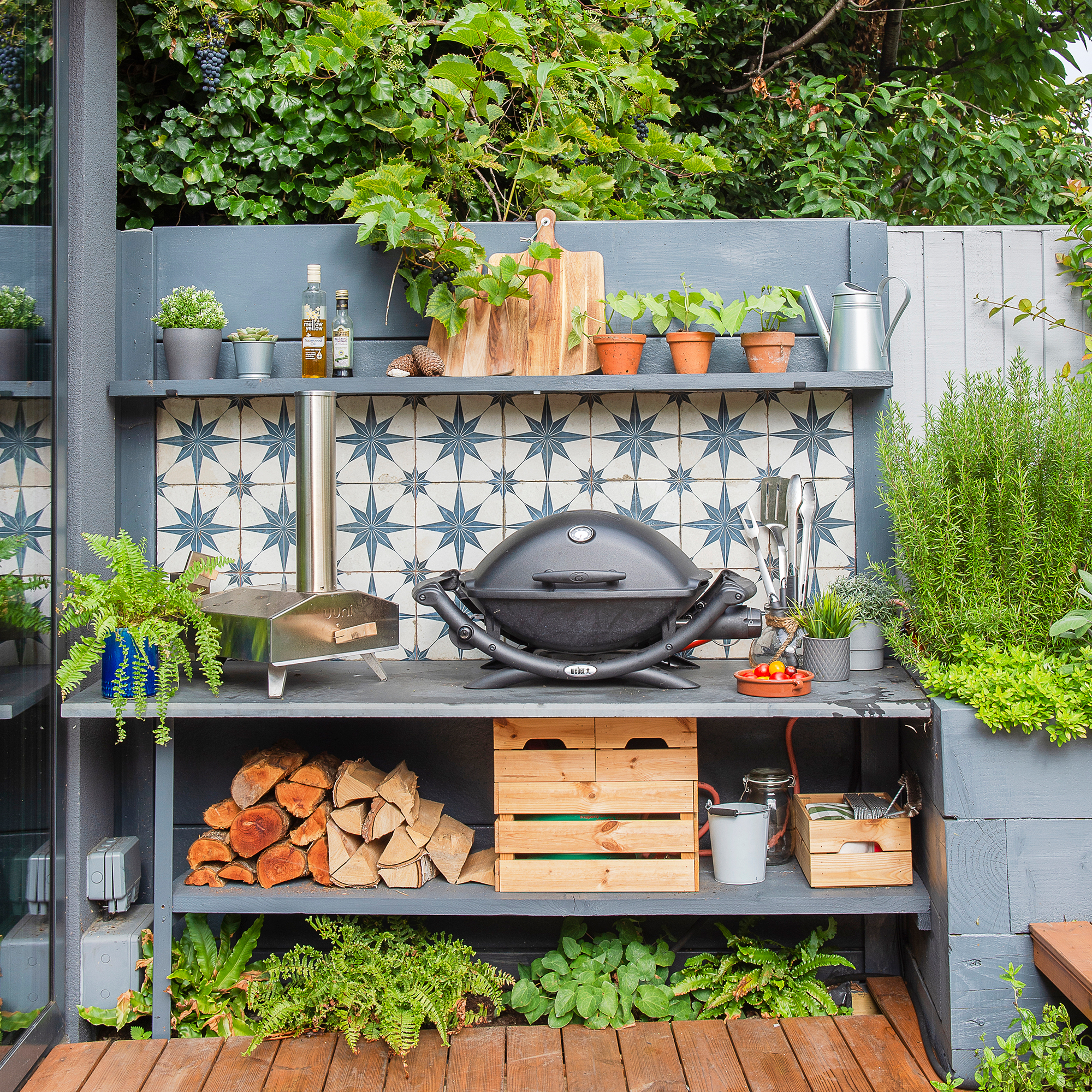
Over the past few years, outdoor kitchens have become a must-have addition to any outdoor space. And while they’re perfect for family BBQs and late-night pizza parties, there are certain design rules for outdoor kitchens that everyone should follow.
If you’re looking to bring your outdoor kitchen idea to life, you probably already understand the value of having one of the best BBQs and best pizza ovens in your life. These outdoor cooking appliances allow you to extend your home beyond its physical limits, but they often need a little oompf in the design department. And that’s where creating a bespoke outdoor kitchen around these appliances can help.
Yes, outdoor kitchens offer more entertaining and relaxation space and can even add value to your home. However, planning an outdoor kitchen requires a lot of research and consideration, which is why we’ve consulted with design experts to put together the ultimate outdoor kitchen design rules.
6 design rules for an outdoor kitchen
‘Outdoor kitchens are a great way of taking your garden to the next level, offering a social space for family and friends to enjoy all year round,’ explains Alice Turner, product expert at Marshalls. But if you’re going to build an outdoor kitchen, there are some design rules you need to follow.
1. It’s all about location
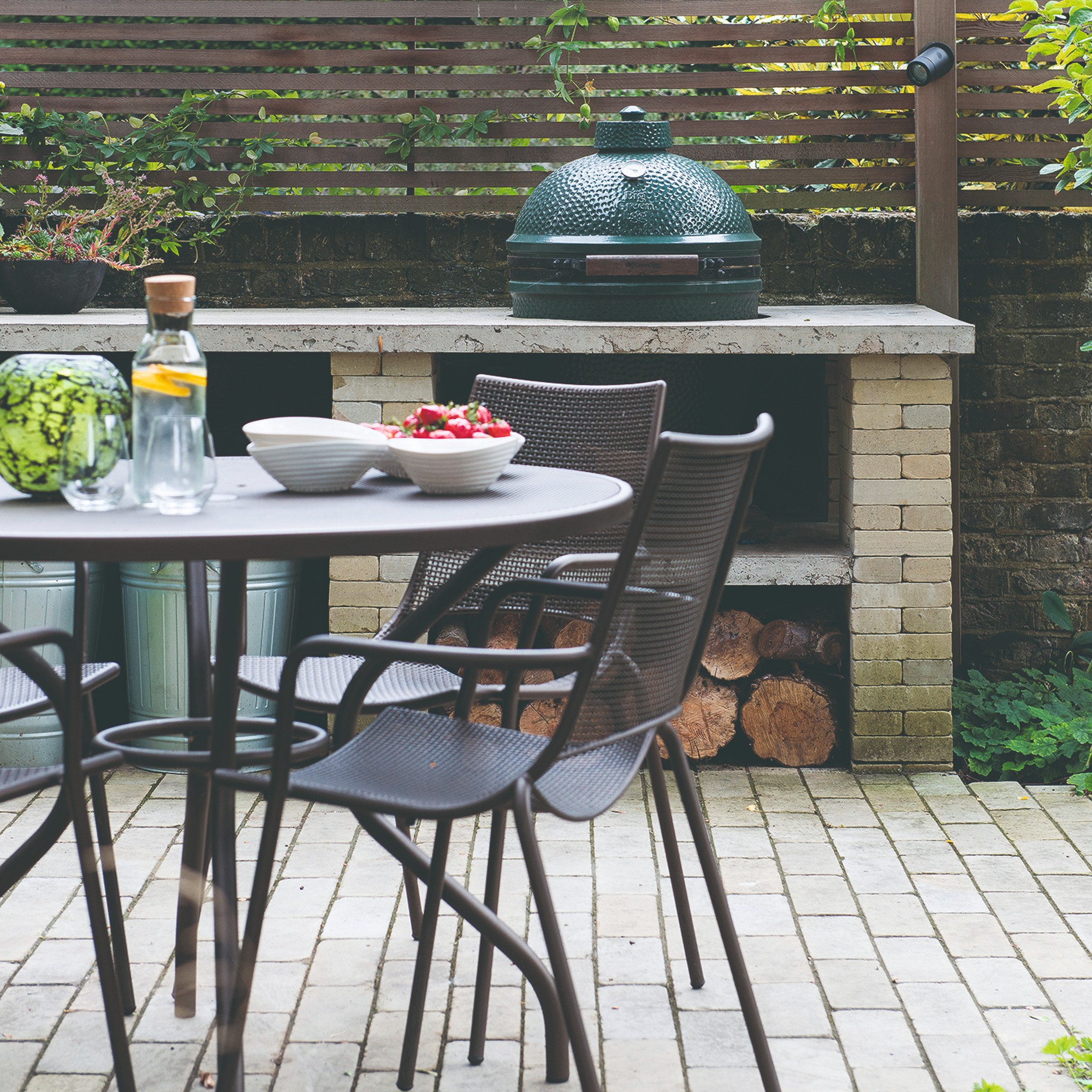
One of the biggest outdoor kitchen mistakes you can make is designing the perfect kitchen in the wrong place. Ideally, you should position an outdoor kitchen within steps of your indoor kitchen so you can use the amenities you may not have in your outdoor kitchen - such as a refrigerator and extra prep space.
Joanna Humphreys, Fire and Stove Specialist at Direct Stoves explains, ‘When designing an outdoor kitchen, the aim is to build something that will be used for a whole season of summer dining. Therefore, it’s important to find the perfect (and practical) spot to work with.’
‘When in the early planning stages, think about your “non-negotiables” (fitting a table next to the kitchen, a good mixture of shade and sun, etc.) and then assess what you have available to you and what can be achieved with the space you have.’
With this in mind, it might be best to merge your outdoor kitchen ideas with your patio ideas instead of building an outdoor kitchen at the end of your garden.
2. Consider zoning
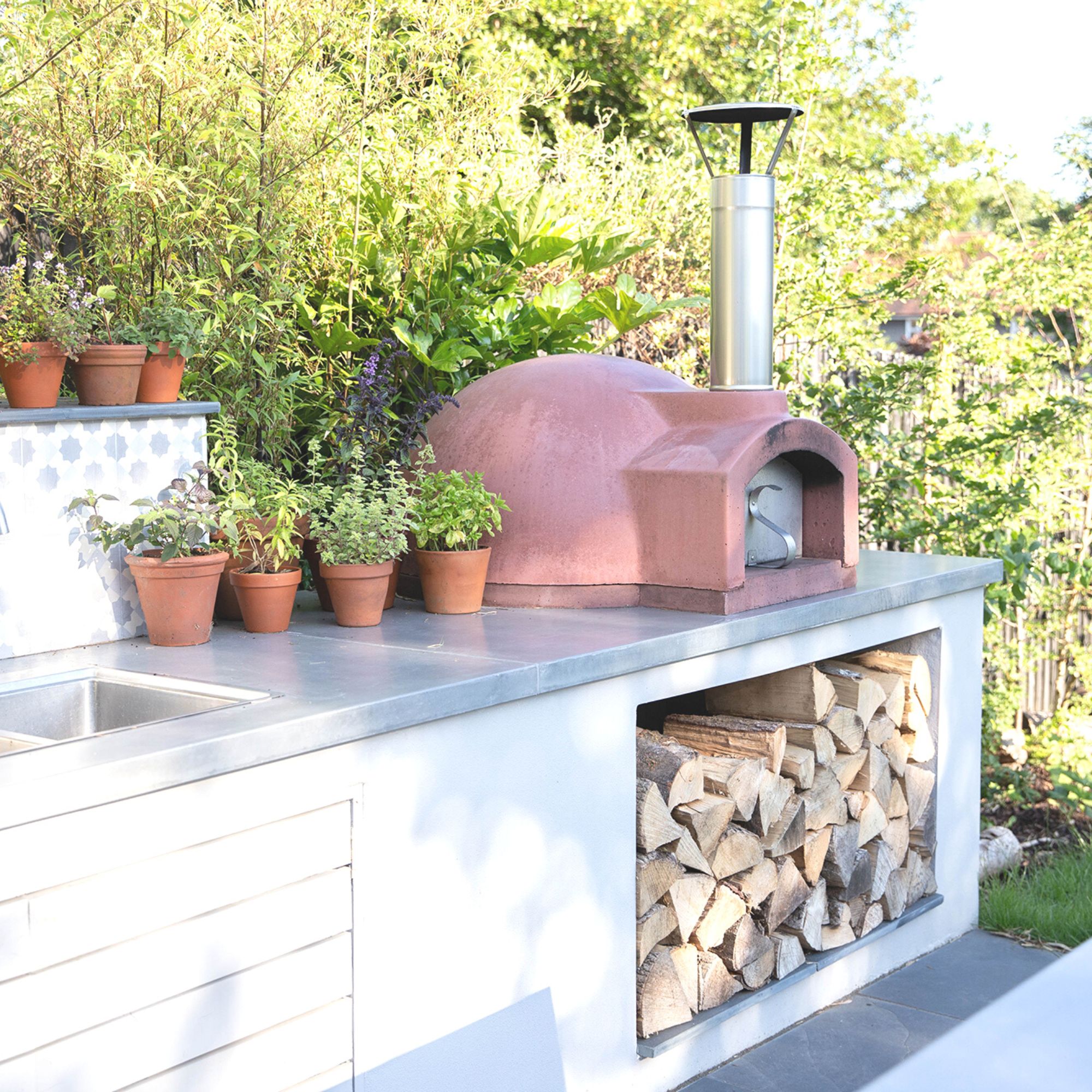
When you’ve settled on the perfect, practical location for your outdoor kitchen, you can then focus on the layout of your outdoor kitchen. According to Gardenstone’s garden landscaping expert, Tom Clifford, you should definitely consider zoning.
‘Like with indoor kitchens, zoning is an important element for enhancing the efficiency of your outdoor kitchen. Zoning is the process of breaking your kitchen up into separate sections, usually six, each with an individual purpose.’
‘The six areas include preparation, cooking, cleaning, consumables, non-consumables and extra space for whatever you decide. The placement of these zones can help your kitchen operate as smoothly as possible.’
‘For example, placing your food preparation zone next to your cooking area will provide efficiency when cooking meals.’
Of course, how you zone your outdoor kitchen depends on the space you’re working with. If you have a small garden and want to make the most of your outdoor space, it may be that you have to sacrifice certain zoning elements and choose small-space-friendly garden furniture.
If you’ve chosen the correct location for your outdoor kitchen and placed it within steps of your indoor kitchen, however, it may not be the end of the world if you have to sacrifice a prep area or an outdoor sink.
3. Flooring is key
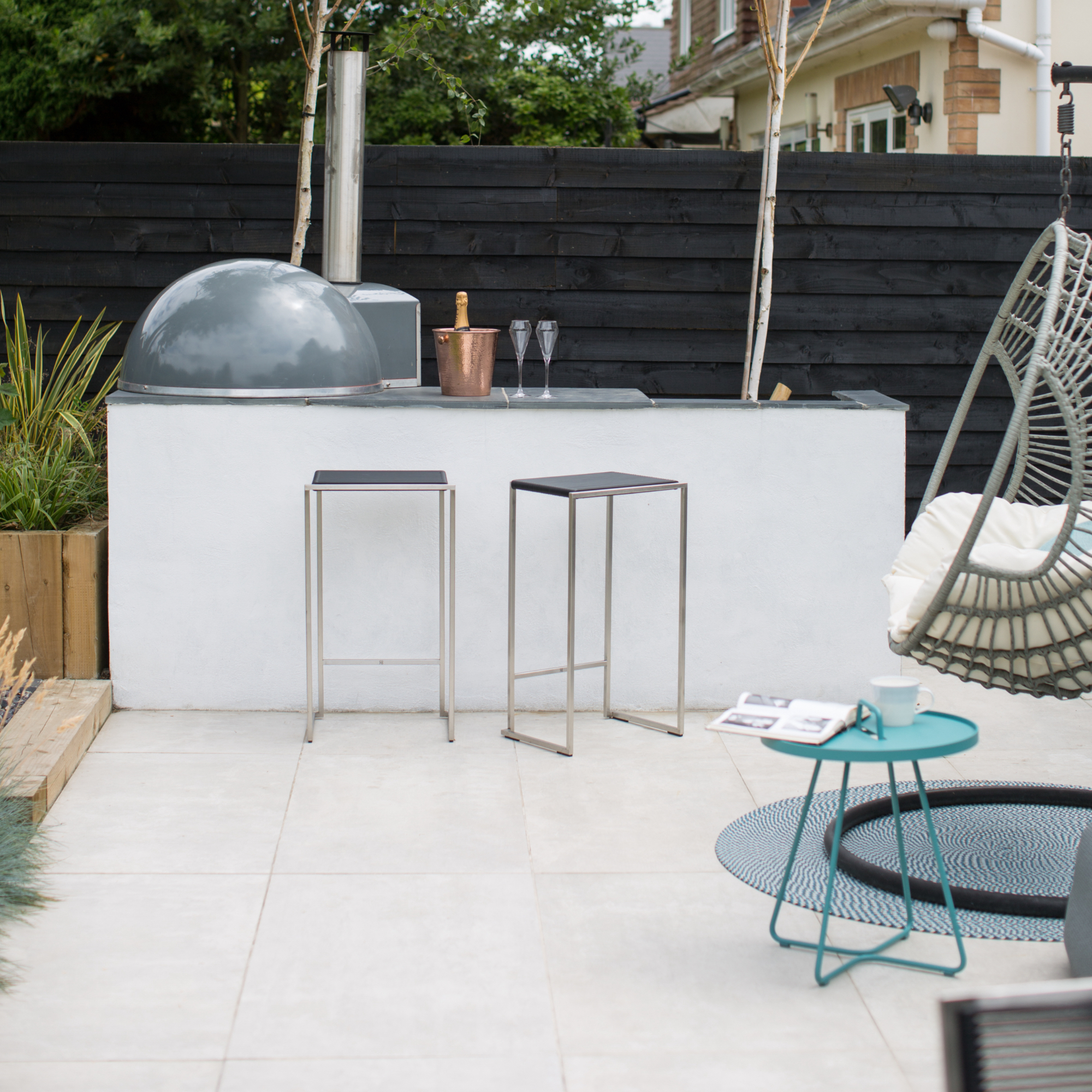
Your flooring choice will not only create a distinction between your outdoor kitchen and the rest of your garden but it will also impact its longevity and appearance. So, it’s best to research the best materials for paving and proceed from there.
‘Selecting the right paving for your outdoor kitchen is essential. You want it to be durable and maintainable whilst also matching your garden and home’s aesthetics,’ explains Alice.
‘Porcelain paving is a popular choice for outdoor kitchens. Being more durable than many other options, outdoor porcelain tiles are less prone to algae or moss growth, and the durability also helps staining.’
‘When it comes to kitchen messes and spills, porcelain is less prone to staining from any food or drink spilt on them and are quick and easy to wipe clean. Not only are these a practical choice, but they are also an attractive addition to your property, offering a modern contemporary look to your garden.’
There are other options out there, though. For those who want a more rustic feel to their outdoor kitchen, Alice suggests using porcelain plank paving or Indian sandstone paving. And if you want something dark and moodier (to hide those ketchup stains), she suggests slate.
Just remember to read up on how to clean a patio to ensure your outdoor kitchen floor is spotless at all times. After all, it’s still a kitchen.
4. Choose the right appliances
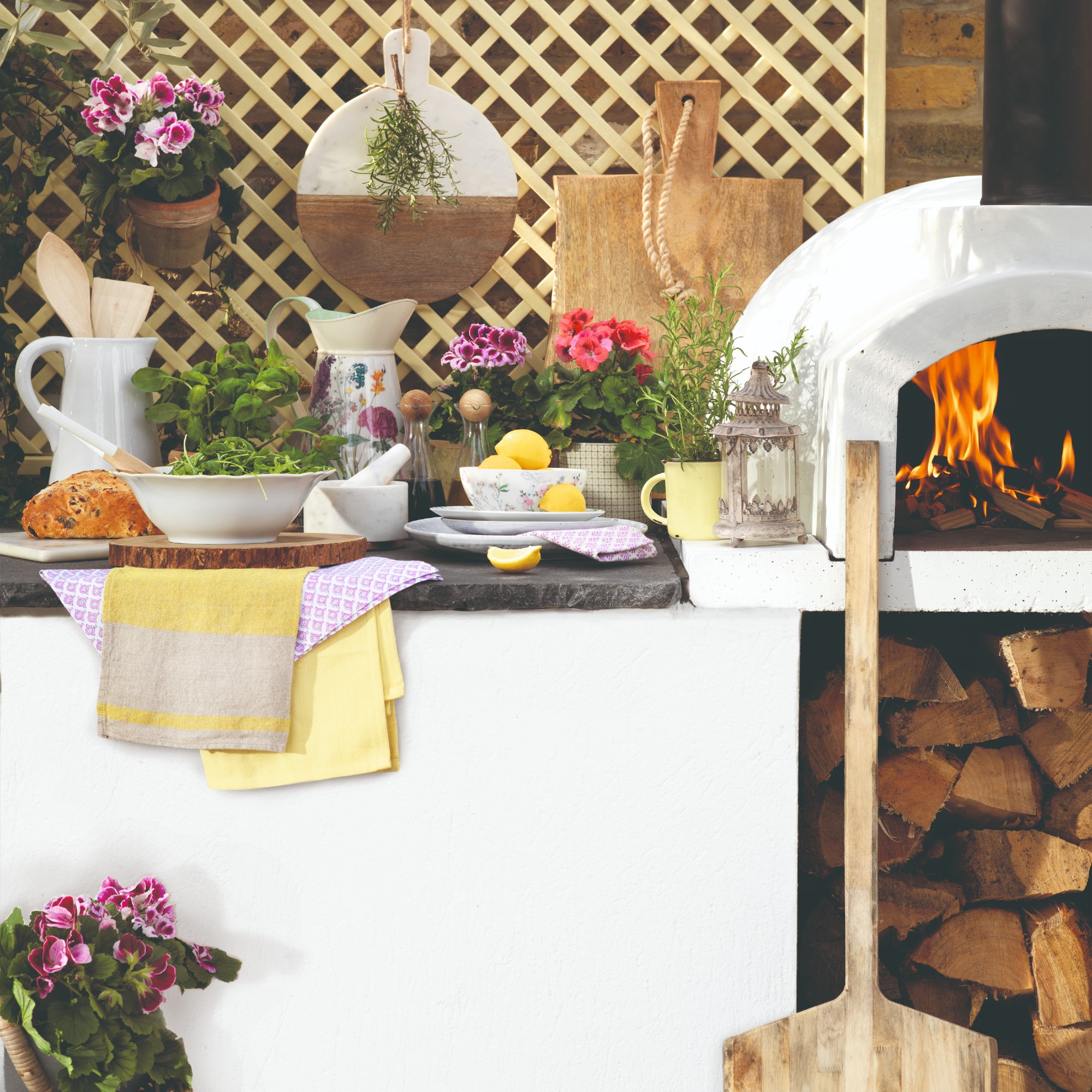
No indoor kitchen would be complete without appliances, and the same can be said for outdoor kitchens. But when designing an outdoor kitchen, you need to consider practicality and aesthetics when buying appliances.
After all, BBQs come in so many different shapes and sizes, so you have to decide whether to opt for a traditional gas BBQ or amp up the style factor and decide between a Big Green Egg and a Kamado Joe. Alternatively, you could make a pizza oven the focal point instead.
Joanna says, ‘Inject a bit of Italian chic into your garden and try adding a pizza oven. The perfect complement to BBQs and grills, a pizza oven opens up even more possibilities and is a great way to get the whole family involved.’
Plus, you have the option to choose a pizza oven based on your outdoor kitchen’s design aesthetic. You could choose one of the best pizza ovens for a modern, off-the-shelf look, or you could stretch your DIY fingers and build your own brick pizza oven.
If you have space and the budget allows, Joanna would also suggest adding an outdoor sink. ‘Not only will it save time when it comes to food prep and tidying up, but it will make your new alfresco kitchen feel really self-sufficient!’ she says.
And when you’ve focused on the basic appliances, you can then focus on the smaller appliances that will benefit you and your outdoor cooking adventures.
5. Add a layer of protection
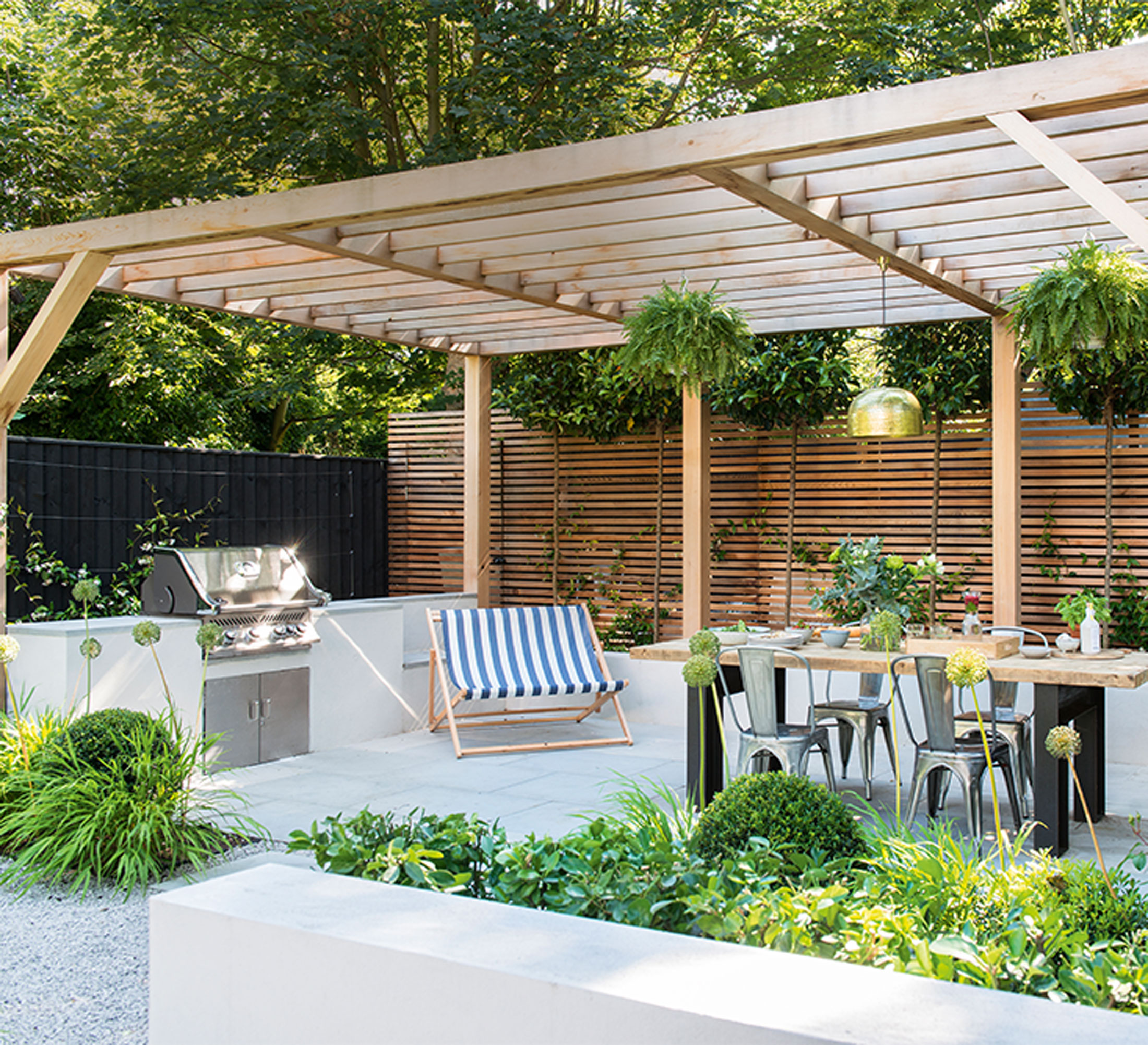
When designing an outdoor kitchen, it’s also a good idea to think about what’s going on above an outdoor kitchen. In England, that’s normally a lot of rain. So, it’s worth choosing a patio cover idea and adding an extra layer of protection.
Tom explains, ‘It is important to protect your kitchen from harsh weather conditions. To protect from rain, ensure your kitchen area is placed under sufficient shelter with a drip edge trim incorporated. A drip edge shelter will direct any surface runoff away from your kitchen so it doesn't drip all over the surfaces and equipment.’
This patio cover won’t just protect your outdoor kitchen from rain, though. It’ll also protect it from damage caused by the various other weather systems we experience in the UK.
‘For kitchens in sunny locations, avoid surfaces that conduct heat, like metals, as they will likely get hot and can be impractical. In addition, incorporating a shelter may be necessary to avoid long-term UV damage in your kitchen, especially with areas made from wood or concrete.’
‘Shelter can also be helpful if your kitchen is placed in a location susceptible to high winds. Not only can winds be generally annoying and disruptive when cooking, but if you’re using open flames, it may pose a fire risk.’
You must remember this layer of protection when designing your outdoor kitchen, as it’ll protect all of your expensive appliances and give you the option to use your outdoor kitchen come rain or shine.
6. Don’t forget the little details
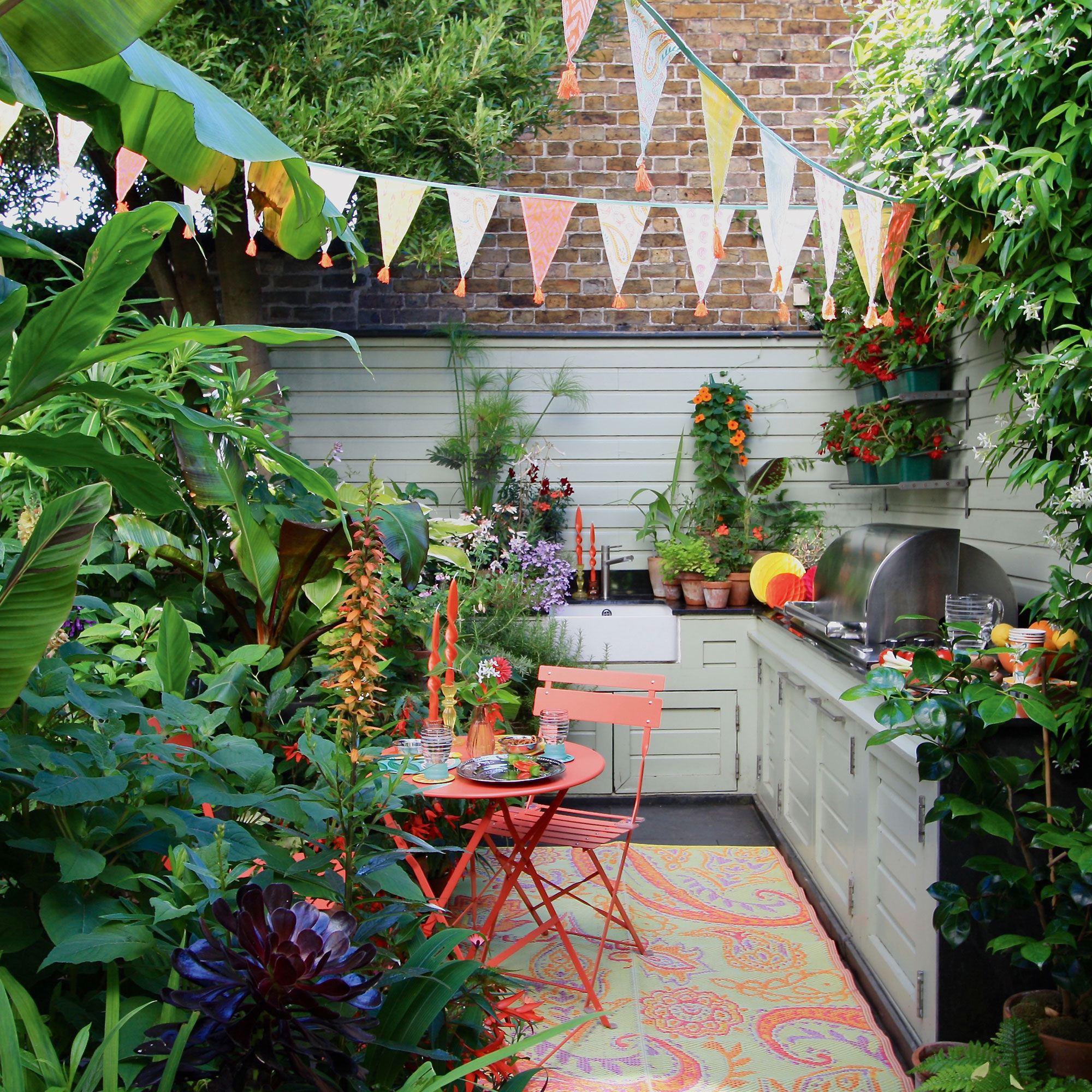
The beauty of designing your own outdoor kitchen means that you can buy or build a space that suits your cooking needs and your style perfectly. And while you can do this with bespoke storage options (don’t forget about the storage!) and the furniture you choose, you can also do this with the little details.
Tricia Guild OBE, Founder and Creative Director for Designers Guild, says, ‘However practical outdoor kitchens may be, they should still have serious design elements. Add personality with a good dose of colour and bold prints to lift what is a seemingly functional space.’
‘Incorporating outdoor cushions and rugs is a great way to ensure that your outdoor space feels comfortable, bringing a sense of harmonious balance that reflects your design preferences. Durable, patterned prints are recommended to combat any spillages or mishaps that may occur from dining alfresco.’
Of course, no outdoor space would be complete without any greenery, either. Tricia explains, ‘Soften a functional look further by adding plenty of plants and foliage to your outdoor area - this promotes serenity and style.’
And if you want practical greenery that can be moved around to suit the size of your al fresco parties, we’d suggest a container garden. Alternatively, add greenery through patio privacy trees to keep your neighbours’ prying eyes at bay.
FAQs
What to consider when building an outdoor kitchen?
The biggest thing you need to consider when building an outdoor kitchen is the location and the layout. Ideally, you need to place your outdoor kitchen as close to the indoor kitchen as possible so that you can easily move between the two, and you need to choose a layout that works with your space.
If you’re an entertainer, put the cooking appliance in the centre of the space so that you can cook and host at the same time. If you want to keep the keeps out of the way, however, opt to put the hot appliance to the side.
Alongside this, you also need to think about materials and durability. As an outdoor kitchen is exposed to the elements and dealing with constant spills from food and drink, you should focus on adding a patio cover over the durable patio slabs.
What are the most common mistakes that people should avoid when building an outdoor kitchen?
The main mistake people make when they build an outdoor kitchen is not planning ahead. Having a plan of the layout, size, materials, and even the budget can allow you to take a step back and consider whether you’re making the correct options for your space.
Another mistake people make is thinking about aesthetics over practicality. While we all want our outdoor kitchens to look stylish, they also need to be usable spaces. So, plan an outdoor kitchen as though you were designing an indoor kitchen.
Now you know the top design rules for an outdoor kitchen, it’s time to get planning!







